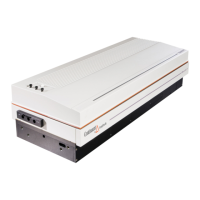32
3.3 SYSTEM START UP
1. Turn on the host laser. Turn the injection seeder Control Switch to STANDBY.
With the host laser Q-switch mode in OFF, or EXTERNAL, turn the lamp power
for both the oscillator and amplifier (if applicable) up to their desired operating
levels. Allow the host laser to warm up for 20 minutes or until external cooling
water is flowing.
2. Turn the Control Switch to ON.
3. Set the Mode Switch to AUTO.
4. Connect a voltmeter to the Build-Up Time BNC. A fast oscilloscope and a fast
detector (response time <1 ns) also can be used to observe laser scatter and
determine the Q-switch build-up time.
5. Observe the Q-switch build-up time voltage with the voltmeter or the Q-switch
build-up time on an oscilloscope. The build-up time reduction can be observed by
changing the Control Switch from ON to STANDBY. Allow 30 seconds for the
seeder to stabilize when switching from ON to STANDBY. If the Q-switch build-
up time is not normal (see Section 1), see procedures for adjusting the mirror
alignment in Section 3.
3.4 SYSTEM CHECK
Proper seeding of the host laser can be checked by observing the output pulses on an
oscilloscope and/or the output through an etalon. Observing the output pulses on an oscilloscope
generally provides better information, and normally it is unnecessary to check with an etalon.
3.4.1 Pulse Trace Observation
Figure 3-3 shows the temporal profile of laser pulses from a seeded and unseeded host laser.
Because the oscilloscope was triggered off the laser pulse, the pictures do not show the pulse-
to-pulse timing jitter or the change in pulse build-up time. If the oscilloscope were triggered off the
Q-switch trigger signal rather than the laser pulse, additional information regarding the timing of the
pulses would be available. In such a case, the pulse should arrive about one pulse width
(approximately 10 nsec) sooner when seeded. Since the locking electronics monitor the pulse build-
up time, it is recommended that the oscilloscope be triggered off the Q-switch trigger rather than the
output pulses to determine how well the system is locking.
3.4.2 Output Through an Etalon
Figure 3-4 demonstrates the characteristic linewidth and stability of a seeded versus unseeded
system. They are both 60 second exposures of a doubled output (532 nm) 20 Hz YAG laser through
a 0.25 cm
-1
etalon. As previously mentioned, it is not necessary to check the output through an
etalon to confirm proper operation. Rather, this test is for double-checking performance. An
explanation of how to set up the etalon is given in Section 4.3.3.
3.5 SYSTEM SHUTDOWN
1. Return the host laser oscillator and amplifier power to their lowest level.
2. Turn the injection seeder Control Switch to STANDBY.
3. Turn the host laser OFF.

